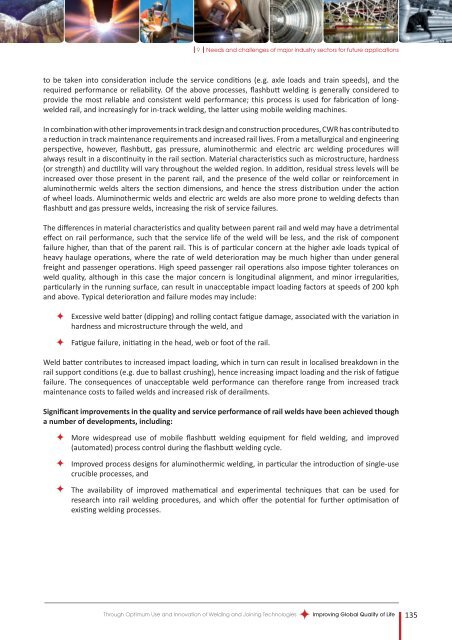Improving Global Quality of Life
Improving Global Quality of Life
Improving Global Quality of Life
Create successful ePaper yourself
Turn your PDF publications into a flip-book with our unique Google optimized e-Paper software.
9 Needs and challenges <strong>of</strong> major industry sectors for future applications<br />
to be taken into consideration include the service conditions (e.g. axle loads and train speeds), and the<br />
required performance or reliability. Of the above processes, flashbutt welding is generally considered to<br />
provide the most reliable and consistent weld performance; this process is used for fabrication <strong>of</strong> longwelded<br />
rail, and increasingly for in-track welding, the latter using mobile welding machines.<br />
In combination with other improvements in track design and construction procedures, CWR has contributed to<br />
a reduction in track maintenance requirements and increased rail lives. From a metallurgical and engineering<br />
perspective, however, flashbutt, gas pressure, aluminothermic and electric arc welding procedures will<br />
always result in a discontinuity in the rail section. Material characteristics such as microstructure, hardness<br />
(or strength) and ductility will vary throughout the welded region. In addition, residual stress levels will be<br />
increased over those present in the parent rail, and the presence <strong>of</strong> the weld collar or reinforcement in<br />
aluminothermic welds alters the section dimensions, and hence the stress distribution under the action<br />
<strong>of</strong> wheel loads. Aluminothermic welds and electric arc welds are also more prone to welding defects than<br />
flashbutt and gas pressure welds, increasing the risk <strong>of</strong> service failures.<br />
The differences in material characteristics and quality between parent rail and weld may have a detrimental<br />
effect on rail performance, such that the service life <strong>of</strong> the weld will be less, and the risk <strong>of</strong> component<br />
failure higher, than that <strong>of</strong> the parent rail. This is <strong>of</strong> particular concern at the higher axle loads typical <strong>of</strong><br />
heavy haulage operations, where the rate <strong>of</strong> weld deterioration may be much higher than under general<br />
freight and passenger operations. High speed passenger rail operations also impose tighter tolerances on<br />
weld quality, although in this case the major concern is longitudinal alignment, and minor irregularities,<br />
particularly in the running surface, can result in unacceptable impact loading factors at speeds <strong>of</strong> 200 kph<br />
and above. Typical deterioration and failure modes may include:<br />
Excessive weld batter (dipping) and rolling contact fatigue damage, associated with the variation in<br />
hardness and microstructure through the weld, and<br />
Fatigue failure, initiating in the head, web or foot <strong>of</strong> the rail.<br />
Weld batter contributes to increased impact loading, which in turn can result in localised breakdown in the<br />
rail support conditions (e.g. due to ballast crushing), hence increasing impact loading and the risk <strong>of</strong> fatigue<br />
failure. The consequences <strong>of</strong> unacceptable weld performance can therefore range from increased track<br />
maintenance costs to failed welds and increased risk <strong>of</strong> derailments.<br />
Significant improvements in the quality and service performance <strong>of</strong> rail welds have been achieved though<br />
a number <strong>of</strong> developments, including:<br />
More widespread use <strong>of</strong> mobile flashbutt welding equipment for field welding, and improved<br />
(automated) process control during the flashbutt welding cycle.<br />
Improved process designs for aluminothermic welding, in particular the introduction <strong>of</strong> single-use<br />
crucible processes, and<br />
The availability <strong>of</strong> improved mathematical and experimental techniques that can be used for<br />
research into rail welding procedures, and which <strong>of</strong>fer the potential for further optimisation <strong>of</strong><br />
existing welding processes.<br />
Through Optimum Use and Innovation <strong>of</strong> Welding and Joining Technologies<br />
<strong>Improving</strong> <strong>Global</strong> <strong>Quality</strong> <strong>of</strong> <strong>Life</strong><br />
135
















